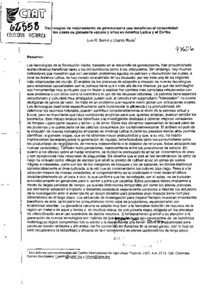Tecnologías de mejoramiento de germoplasma que benefician al consumidor: los casos de ganadería vacuna y arroz en América Latina y el Caribe
However, the distribution of these benefits among consumers and producers greatly varies according to the assumptions made for the type of economy (open or closed). The scenario with a closed economy reveals that the brunt of the benefits (86%) go to consumers; in contrast, in a partially opened economy (where only exports are allowed), producers become important receivers (48%). The ex-ante benefits were calculated using MODEXC, a partial equilibrium model developed at CIAT that calculates consumer and producer surpluses. The analysis ignores the presence of significant distortions in international trade --a major deterrent to food production in developing countries--. Its partial equilibrium approach is also a limitation, as the additional wealth generated by the new technologies generates important backward and forward linkages as well as spillover effects in the rest of the economy that cannot be fully taken into account by the model. However, the results are useful to compare the returns of alternative research opportunities under similar market conditions and to assist decision-makers in establishing research priorities.

